For a while now, I have been turning to Lyptus and Sapelle rather than Honduras or Philippine mahogany for use in transoms, thwarts and gunwales, also to Bubinga for centerboard trunk bedlogs and Zebra for boom crutches and accents.
Familiar names? You won’t find them mentioned in the venerable WOOD: A Manual for its Use as a Shipbuilding Material (Department of the Navy, Bureau of Ships, 1957 (now available through D.N Goodchild), yet chances are if you do an on-line search for boat lumber or walk into your local hardwood dealer you will see some or all of these.
Little to no information on these species appears to have been published prior to the current decade. This includes even Hoadley’s renowned tome, Understanding Wood: A Craftsman's Guide to Wood Technology (either first, 1980 or second, 2000 editions),Taunton Press.
The earliest mentions I could find for all but Lyptus were in 1999’s The Encyclopedia of Wood (Washington, D.C. / U. S. Department of Agriculture—2007 Skyhorse Publishing, Inc. edition) and in more recent works such as John & James Lorette’s The Wood Collection Volume 1 (2001, Rare Materials Press available from www.rarematerial.com) or the un-attributed Woods of the World available as a PDF file download on-line (www.pensbyterry.com/media/wotw.pdf).
Lyptus is not supported in any printed material I could find save Weyerhaeuser’s (descriptive, albeit, non-technical) web site.
My aim in this article is to compare (within the scope of my experience) steam bending and machining characteristics of Lyptus, Sapelle and Bubinga to more familiar woods and provide some idea as to workability and endurance. I rely also on suplemental information and opinions from three very useful web sites: Woodworker’s Source (www.woodworkerssource.net), Woodcraft (www.woodcraft.com) and Luthier’s Merchantile International (www.lmii.com)--Luthier’s, especially, is particularly handy for general bending and finishing charateristics.
Lyptus: Brazil |
 |
“Lyptus” is a registered trademark for a species of hybrid fast growth Eucalyptus tree grown on plantations certified to Brazil’s national sustainable forestry standard and marketed by Weyerhaeuser. Though Lyptus is not listed or described as such in the above referenced books, Eucalyptus (a.k.a Ironbark) has been around for considerable time and is discussed in the Navy’s manual (paragraph 2.2112 Ironbark). The general characteristics described therein and quoted below, may be applied to Lyptus:
Heartwood is red to dark brown, sapwood light colored. The heartwood has good decay resistance and its hardness makes it somewhat resistant to the crustacean forms of marine borers. The wood shrinks moderately, is very heavy and hard, and has good strength properties.
Table 3.1 of the same text lists specific gravity as 1.00 (white oak is .60) and weight per cubic foot as 62 pounds (5 pounds per board foot).
In my projects I have found Lyptus to vary in color from a honey blond to rusty red. Texture is similar to cherry.
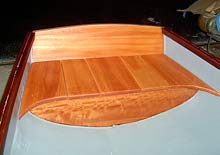 |
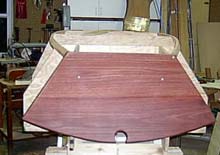 |
Two examples of Lyptus transoms—both oiled
|
In earlier projects grain and color seemed more uniform than what I am seeing now and recent examples have shown some insect holes. Supply quantity seems good, however, and with some selective culling good color and quality may be had.
Lyptus, as with its other Eucalyptus family members, is a noticeably heavy wood. I have found it to take epoxy well, machine readily with power/hand tools and hold fastenings similarly to hard cherry or maple (using pilot holes). It is somewhat more resinous than either cherry or maple and I experienced problems getting sound joints in the small box below when using Elmer’s Carpenters Wood Glue—in the end going to epoxy.
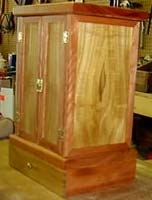 |
Lyptus/myrtle jewelry box—glue issues |
Also, I have not found Lyptus to steam bend particularly well but have had good luck in laminating. Current pricing is $4.49 to $5.80 per board foot (4/4 S2S).
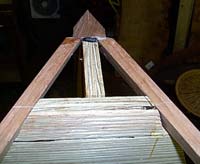 |
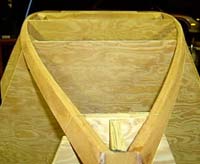 |
Chine timbers laminated of two 3/8 x 1 pieces of Lyptus.
|
Sapele: (Entandrophragma cylindricum) Africa |
 |
According to Woodcraft’s web site: “Rich, lustrous, and variable reddish-brown color. Moderately durable. Works without difficulty with both hand and machine tools. Nails, screws, and glues well. Provides an excellent polished finished. Used for quality furniture and cabinetmaking, solid doors, and musical instruments.” LMI states, “Sapele...is a little heavier and finer textured than Honduran Mahogany.”
The Lorettes give specific gravity as 0.62 and weight at 39 pounds per cubic foot (3.25 pounds per board foot) which puts it on par weight wise with any of the pines normally considered for small boat thwarts—thus providing a choice of better figured and more durable wood without adding weight above the water line.
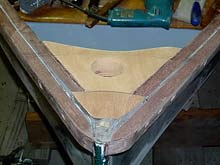 |
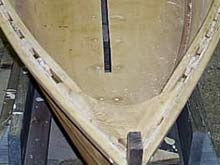 |
Color comparison: Philippine on left with Honduran mahogany breasthook.
Sapele on right.
|
I have found Sapele to run from light tan to brown. The USDA reports Sapele to be harder than Honduras mahogany, which undoubtedly is true; however, in use it works more easily than Philippine and in similar section/length steams and bends more readily. It glues exceptionally well with epoxy and provides excellent hold with fasteners. The Lorettes close their description of Sapele with a bit of folklore—indicating Sapele was the wood used for zeppelin propeller blades.
Current pricing is $7.50 to $9.99 per board foot (4/4 S2S).
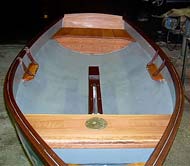 |
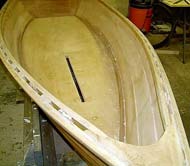 |
Steam bent wales—Philippine/Sapele
|
Bubinga: (Guibourtia spp.) Africa |
 |
LMI assesses Bubinga thusly, “… sometimes known as African Rosewood, although it’s not a Dalbergia. The most common varieties being used for instruments include Didelotia Africana and Guibourtia demeusei, one of four Guibourtias known as Bubinga. It has a medium texture with interlocking grain, and when finished gives a mottled “bees wing” appearance. Its pinkish-mauve cast oxidizes to a nice brownish-red over time. Because of its interlocking grain, it can be like some of the more difficult Mahogany to bend.”
To this the Lorettes add, “If the wood is heated, such as steam-bending, the gum may exude from the wood making application of finish difficult”. This same gum, they say, may cause problems gluing. Woodcraft specifies, “…turns well and takes a high polish. Machines well with sharp tools.”
I have employed Bubinga as centerboard trunk bedlogs in 5/4 by 6/4 section. Machining, sawing/drilling was readily accomplished—I did bedlog boltholes with an ancient brace & bit with ease. It seems to resemble teak when sanding with the same powdery dust. Initially, I found it tough to hand plane even with bees wax. I ended using tallow rubbed along the wood’s edge before each pass. This worked wonderfully and allowed full-length curls to be cut.
I am undecided about epoxy: two joints does not an expert make. Under non-stress conditions, in the shop, indications are the bedlog to trunk side joint bonded successfully. However, having witnessed the fallout first hand of lost bulb keels and sailors due to bond failure (and myself having lost a mast step) when no mechanical fasteners were employed, I will error on the side of caution—heeding the Lorette’s note, supplemental bronze screw fastenings were installed during final assembly. Current pricing is $8.50 to $11.99 per board foot (4/4 S2S).

Bubinga bedlogs |
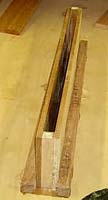 |
Zebrawood: (Microberlinia brazzavillenis) Africa |
 |
Woods of the World says it has a high luster, and the grain is usually interlocked or wavy, with a medium to coarse texture and good finishing and polishing characteristics. Common uses include boat building, decorative veneer, furniture, dowels, floor lamps, and cabinets. While Woodcraft states, “Medium to heavy hardwood with possible coarse to very coarse grain texture depending on how it is cut. Light tan to golden yellow with streaks of dark brown to black.”
I must admit I have not used Zebrawood structurally in anyway within the scope of boat building nor do I ever recall seeing it used as other than riser stock in bow making (archery) where it has always been a favorite. I did make one boom crutch from it, and found it to machine easily, sand well and take varnish readily. It is a moderate weight wood. Woodworkers Source rates it just under red oak in weight while the Lorettes rate it just above with a specific gravity of 0.77 and weight of 4.5 pounds per board foot. Though too pricey for general boat use, I believe it would make an excellent choice for block shells—a test I intend to put it to in the not too distant future. Current pricing is $16.00 to $18.99 per board foot (4/4 S2S).
Wych Elm: One other wood I’d like to include is Wych Elm. Mentioned by John Leather in his Clinker Boatbuilding, (Adlard Coles Ltd. 1987 edition) as planking stock, it is a wood not often seen here in the states and though Culler mentions it also I have not yet found any in “boat quality”; however, some full 4/4 knarled flitch cut stock offered by Hearne Hardwoods Inc. (www.hearnehardwoods.com)as English Wych Elm has proven useful for getting out small natural crook knees and breasthooks (by laying out cuts to follow the swirling grain patterns). Pricing varies by piece.
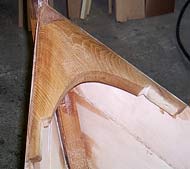 |
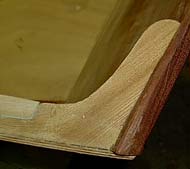 |
Natural crooks cut from Wych Elm
|
|
Hearne Hardwoods - Wych Elm |
|

